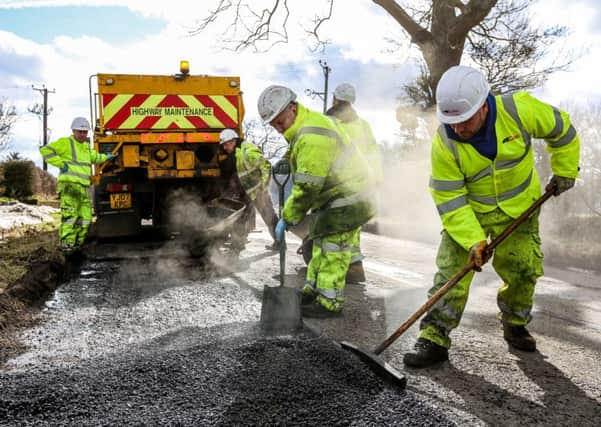PROBE INTO POTHOLES: How the council deals with all the holes in the roads


Potholes are a scourge on the road network at the best of times, but the particular weather this winter followed by the Beast from the East has exacerbated the problem this year.
A combination of sub-zero temperatures, rain and snow throughout winter, with repeated cycles of freezing and thawing, has taken its toll on the county’s highways and led to a large increase in the number of potholes being identified throughout Northumberland.
Advertisement
Hide AdAdvertisement
Hide AdIt had previously been announced that the local authority had been awarded an extra £930,000 of government funding, topped up by £420,000 of council reserves and last week, it was revealed by the Department for Transport that Northumberland will receive £1.85million from a £100million national package to help repair potholes and other storm damage.
This money is being spent on increased road inspections, extra equipment and resources, and a range of repair work, where possible using techniques that provide for a longer-term fix in which the damaged patch of road surface is cut out and repaired.
Repairs are split into two categories; those just fixing the pothole and those involving patching.
The works involving fixing the pothole are generally to repair any which could cause an immediate danger to road users.
Advertisement
Hide AdAdvertisement
Hide AdThese are carried out to keep the road network safe from what are describes as hazardous defects.
While Northumberland County Council is moving towards carrying out more of the repairs as patch repairs, this is not possible in all cases as they take longer to carry out, cannot be undertaken in all weather conditions and sometimes require road closures because of the extra plant and machinery required to do the work – a road closure legally requires six weeks’ advance notice.
The repair to a pothole involves a two-man operations gang using hand tools and a vibrating plate or hand beater to compact the repair materials.
In general, a hot, bitumen-coated aggregate material is collected from a local plant for use in the repairs.
Advertisement
Hide AdAdvertisement
Hide AdHowever, in some cases, a specialist cold-mix material can be used for emergency repairs where hot-coated material isn’t available.
Highway inspectors often carry this material so they can carry out a repair themselves where necessary.
The process for a pothole repair is usually:
Arrive on site and set up temporary traffic signs; sweep debris out of hole and remove;
Place selected material in the area;
Use vibrating plate or hand beater to compact material; clear area and make sure that it is safe for road users.
Advertisement
Hide AdAdvertisement
Hide AdWhere patching takes place, this involves a variety of equipment, material and operations.
The machinery includes:
A hotbox wagon, which has a heated holding area for keeping the material hot;
Aroad planer, which removes the top surface and levels the area;
A JCB or loader that’s used to remove the planed-off, unsuitable material and load this into a tipper wagon to be taken away for recycling;
Advertisement
Hide AdAdvertisement
Hide AdA mechanical sweeper to pick up any smaller loose materials and clean the area ready for the material;
A vibrating roller to roll out and compact the fresh material.
In terms of the material, a 10mm aggregate mixed with a bituminous binder is used.
To ensure that the material meets the correct specification, it must be laid at a temperature of around 90 to 100 degrees which is why a hot box is used to retain the heat.
Advertisement
Hide AdAdvertisement
Hide AdTo ensure that the new tar binds to the existing road, a bituminous binder is used which acts like a glue, it also seals the edge to ensure that the patch is water-tight.
A typical patching repair needs a number of trained highways staff to carry out the various roles – HGV driving, planing and sweeping, spreading and levelling, and rolling the final surface.
The process for patching is:
* Set up traffic management (eg, temporary traffic lights);
* Plane out existing damaged road material;
* Sweep up existing material and remove spoil to tip;
* Apply bituminous binder;
* Place tar into patch and level slightly higher to allow for compaction;
* Roll patch with vibrating roller until flush with surrounding road level;
* Seal edges with bituminous binder;
Advertisement
Hide AdAdvertisement
Hide Ad* Allow to cool before traffic can run to ensure material meets the correct specification.
Reacting to last week’s allocation of additional funding, Coun Glen Sanderson, cabinet member responsible for highways, said: “Like many parts of the country we’ve had a prolonged spell of wintry weather which has caused a great deal of damage to our road network. I’m pleased we’ve been able to secure extra funding for pothole repairs as we’ve been calling on the government for extra support.
“We know how vital our roads are in connecting communities and allowing people to travel freely across our county. This latest money will allow us to continue our ongoing pothole repair programme across Northumberland.
“However, we will also continue to press our case that Northumberland has been hit particularly badly by the severe weather this winter.
Advertisement
Hide AdAdvertisement
Hide Ad“While this additional pothole funding is warmly welcomed, further support is required to ensure we can repair all of the wider and underlying damage that has been caused to our highway network and not just to repair individual potholes as they appear.”